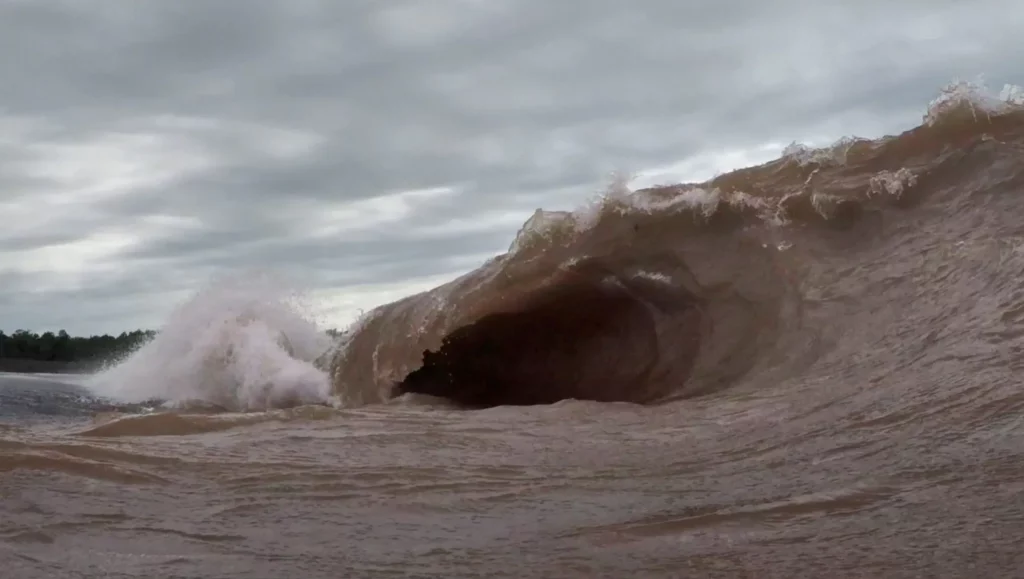No, flying over a tsunami is not possible or safe. Tsunamis can reach great heights and cause catastrophic damage on land and in the ocean.
So, can you fly over a tsunami? Honestly, flying over a tsunami is impossible due to the nature and characteristics of a tsunami.
Tsunamis are massive ocean waves that are typically triggered by underwater earthquakes, volcanic eruptions, or landslides. These waves can travel at high speeds over long distances, causing immense destruction along coastal areas.
The height and power of a tsunami wave can be dangerous and potentially fatal. Therefore, attempting to fly over a tsunami would put aircraft and passengers at significant risk.
It is crucial to prioritize safety during natural disasters like tsunamis and focus on evacuation, emergency response, and aiding affected areas.
Can You Fly Over A Tsunami?

People often ask if it is possible to fly over a tsunami due to the immense destructive power associated with these natural disasters.
The question arises from a combination of curiosity, concern for safety, and a desire to understand the limitations of air travel during such catastrophic events.
Now, can you fly over a tsunami, or should you cancel your trip when there’s the probability of a Tsunami?
Flying over a tsunami is extremely dangerous and not recommended. Tsunamis generate massive, powerful waves that can reach great heights, causing turbulence and posing significant risks to aircraft.
These waves can also carry debris and create unpredictable wind patterns, making flying over a tsunami zone a severe hazard. Aviation authorities strictly prohibit flights in areas affected by active tsunamis due to the potential for catastrophic accidents.
In the interest of safety, pilots are advised to avoid such regions and follow guidance from air traffic control and weather agencies to prevent any potential encounters with these destructive natural events.
What Are the Overall Risks of Flying Over Tsunamis?
Tsunamis are powerful and destructive natural phenomena characterized by massive waves that can travel across vast distances.
When thinking about flying over tsunamis, the plane’s height and speed, distance from the epicenter and coast, and the tsunami’s size and strength all play a part in the potential risks.
Let’s comprehensively analyze the overall risks of flying on a tsunami for your safety during the air flight.
- Physical hazards:
Flying over tsunamis poses a significant physical risk to aircraft. Tsunamis can generate powerful and unpredictable waves that can damage or destroy aircraft in their path.
These waves can exert immense force on the aircraft, causing structural damage, engine failure, or loss of control.
- Turbulence and instability:
Tsunamis create chaotic and turbulent conditions in the air, which can be extremely challenging to navigate for pilots.
The abrupt changes in air pressure, wind speed, and direction can lead to severe turbulence and instability, making it difficult to maintain aircraft control.
- Limited visibility:
Tsunamis often generate massive amounts of spray and mist, reducing visibility for pilots.
The combination of high sea levels, heavy rainfall, and strong winds can create a dense wall of water particles, obscuring the pilot’s view and making it challenging to identify critical landmarks or obstacles.
- Unpredictable debris:
Tsunamis can sweep large amounts of debris and wreckage into the air. This debris, such as trees, building materials, and other structures, can become airborne and pose a significant risk to aircraft.
Flying over a tsunami-affected area increases the likelihood of encountering airborne debris, which can cause severe damage to an aircraft’s engines, wings, or other vital components.
- Communication and navigation challenges:
Tsunamis can disrupt or damage communication infrastructure and navigation aids, making it challenging for pilots to communicate with air traffic control and navigate accurately.
Without reliable communication and navigation systems, pilots may struggle to receive crucial updates, weather information, or assistance in avoiding hazardous areas.
- Unpredictable weather patterns:
Tsunamis can generate severe weather conditions, such as thunderstorms, high winds, and heavy rain. These adverse weather conditions further increase the risks associated with flying over tsunamis.
Thunderstorms, for example, can produce strong updrafts and downdrafts, creating dangerous turbulence and potentially damaging the aircraft.
- Rescue and recovery operations:
Flying over tsunamis can hinder ongoing rescue and recovery operations. First responders, including helicopters and other aircraft involved in search and rescue efforts, need clear airspace and uninterrupted access to affected areas.
Extending over tsunamis introduces additional risks, potentially interfering with these critical operations.
Overall, flying over tsunamis poses significant risks to both the aircraft and the individuals aboard. Aviation authorities and pilots must prioritize safety and avoid flying over tsunami-affected areas to mitigate these potential dangers.
FAQs
Why can’t planes fly over tsunamis?
Tsunamis can generate massive waves that extend high into the atmosphere, creating turbulence and posing a hazard to aircraft.
Are there any regulations against flying over tsunamis?
While specific regulations may vary, aviation authorities generally prohibit flying over areas with active tsunamis due to the associated risks.
How far inland can a tsunami’s impact be felt?
Tsunamis can inundate coastal areas, flooding several miles inland in some cases, depending on factors like wave height and coastal topography.
What are the dangers of flying near a tsunami’s impact zone?
Flying near a tsunami’s impact zone can expose aircraft to unpredictable turbulence, strong winds, and debris, jeopardizing flight safety.
Can helicopters fly over tsunamis to rescue people?
Helicopters may be used for rescue operations, but they need to maintain safe distances from the tsunami’s impact area to avoid hazardous conditions.
How high can tsunami waves reach into the atmosphere?
Tsunami waves can reach varying heights, but some can extend hundreds of feet into the air, making them dangerous for aircraft.
What’s the best way for pilots to avoid tsunamis while flying?
Pilots should consult with air traffic control and weather services to receive updated information on tsunami activity and adjust flight paths accordingly.
Can pilots detect tsunamis while in flight?
Pilots can receive information about tsunami threats through air traffic control and onboard weather systems, helping them make informed decisions.
Conclusion
Tsunamis are powerful and destructive natural disasters that produce massive waves and powerful surges of water. So, when the gradual concern comes, “Can You Fly Over A Tsunami” the answer is pretty simple.
Flying over tsunamis is dangerous and not recommended. Attempting to fly over a tsunami puts individuals at risk of being caught in the turbulent and unpredictable forces of the tsunami, leading to potential loss of control, damage to the aircraft, and loss of life.
Indeed, it is crucial to prioritize safety and avoid flying in tsunami-affected areas to prevent unnecessary harm to oneself and others.

